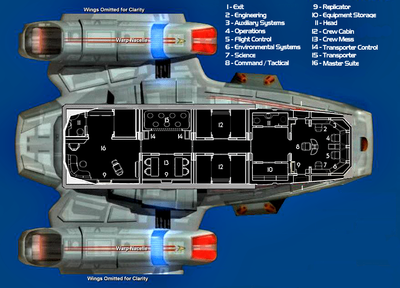| Line 6: | Line 6: | ||
The ship was designed to phase out the aging Excelsior Class as a medium range exploration vessel and support for the Galaxy Class starship. She is designed with a highly advanced power system and computer technologies as compared to earlier ship designs. During the design phase the vessel was also given additional consideration for the Borg threat, which was giving [[Starfleet]] Command considerable distress in coming up with methods of dealing with that threat. This anxiety gave rise to an alteration of the design paradigm of many vessels. | The ship was designed to phase out the aging Excelsior Class as a medium range exploration vessel and support for the Galaxy Class starship. She is designed with a highly advanced power system and computer technologies as compared to earlier ship designs. During the design phase the vessel was also given additional consideration for the Borg threat, which was giving [[Starfleet]] Command considerable distress in coming up with methods of dealing with that threat. This anxiety gave rise to an alteration of the design paradigm of many vessels. | ||
There are two obvious and highly notable design changes from the traditional ship designs; the warp drive system uses a unique method to change the warp field geometry where the actual warp nacelles themselves move and the vessel is equipped to actually land on a planet's surface, a design choice that was pioneered in the [[Nova Class Starship]]. Like most Starfleet ships of the era, it also has a primary auxiliary craft, called the Aerowing Shuttle docked at the ventral section of the saucer. | There are two obvious and highly notable design changes from the traditional ship designs; the [[Warp Drive|warp drive]] system uses a unique method to change the warp field geometry where the actual warp nacelles themselves move and the vessel is equipped to actually land on a planet's surface, a design choice that was pioneered in the [[Nova Class Starship]]. Like most [[Starfleet]] ships of the era, it also has a primary auxiliary craft, called the Aerowing Shuttle docked at the ventral section of the saucer. | ||
; Dimensions : 344 x 130 x 63 meters | ; Dimensions : 344 x 130 x 63 meters | ||
| Line 43: | Line 43: | ||
=== Offensive Systems === | === Offensive Systems === | ||
* 2 Type V [[Phaser]] Arrays | * 2 Type V [[Phaser]] Arrays | ||
* 2 Type VI Phaser Arrays | * 2 Type VI [[Phaser]] Arrays | ||
* 2 Microtorpedo Launchers (1 Fore, 1 Aft) | * 2 Microtorpedo Launchers (1 Fore, 1 Aft) | ||
| Line 50: | Line 50: | ||
=== Interior === | === Interior === | ||
The inside of the Aerowing Shuttle is designed as an advanced form of Runabout (similar to the [[Danube Class Runabout]]) but with a focus on the vessels extended range. Configurations for the crew quarters to have either double bunks each or single bunks depends on the required crew capacity. Though for extended missions it is | The inside of the Aerowing Shuttle is designed as an advanced form of Runabout (similar to the [[Danube Class Runabout]]) but with a focus on the vessels extended range. Configurations for the crew quarters to have either double bunks each or single bunks depends on the required crew capacity. Though for extended missions it is recommended to use the single-bunk configuration. | ||
The mission commander is also given a large crew quarters / ready room at the aft of the ship. | The mission commander is also given a large crew quarters / ready room at the aft of the ship. | ||
Revision as of 16:31, 1 May 2017
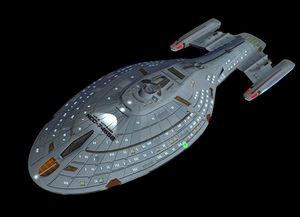
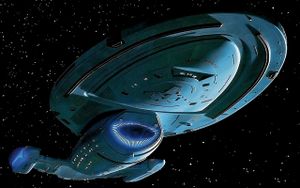
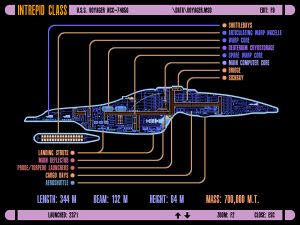
The Intrepid Class Starship is one of the fastest and most maneuverable vessels designed by Starfleet. Capable of even maneuvering safely through the dense plasma fields in the Bajoran sector. The class was made famous in the public view after the heroic return of the USS Voyager from the Delta Quadrant and thus the design and that ship in particular became well known among the public throughout most of known space.
The ship was designed to phase out the aging Excelsior Class as a medium range exploration vessel and support for the Galaxy Class starship. She is designed with a highly advanced power system and computer technologies as compared to earlier ship designs. During the design phase the vessel was also given additional consideration for the Borg threat, which was giving Starfleet Command considerable distress in coming up with methods of dealing with that threat. This anxiety gave rise to an alteration of the design paradigm of many vessels.
There are two obvious and highly notable design changes from the traditional ship designs; the warp drive system uses a unique method to change the warp field geometry where the actual warp nacelles themselves move and the vessel is equipped to actually land on a planet's surface, a design choice that was pioneered in the Nova Class Starship. Like most Starfleet ships of the era, it also has a primary auxiliary craft, called the Aerowing Shuttle docked at the ventral section of the saucer.
- Dimensions
- 344 x 130 x 63 meters
- Crew
- 150 (30 Officers / 120 Enlisted)
- Power Sources
- Matter/Antimatter Reactor
Fusion Reactors - Propulsion
- Warp Drive
Impulse Drive - Cruising Speed
- Warp 6
- Flank Speed
- Warp 9.975
- Burst Speed
- Warp 9.995 for 1 Hour
Offensive Systems
- 13 Type X Phaser Arrays
- 2 Fore / 2 Aft Torpedo Launchers
Defensive Systems
- Deflector Shields
Auxiliary Craft
- 1 Aerowing Shuttle
- 1 Type 11 Shuttlecraft
- 12 Type 9 Shuttlecraft
- 4 Type 7 Shuttlecraft
Aerowing Shuttle
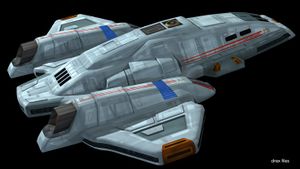
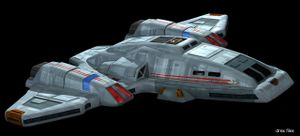
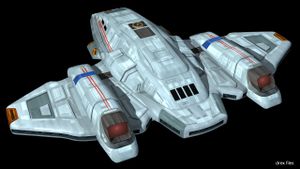
- Dimensions
- 24.8 x 29.6 x 4.1 meters
- Crew
- 5 Standard / 8 Maximum / 1 Minimum
- Power Sources
- Matter/Antimatter Reactor
Fusion Reactors - Propulsion
- Warp Drive
Impulse Drive - Cruising Speed
- Warp 5
- Flank Speed
- Warp 6.5
- Burst Speed
- Warp 7.12 for 1 Hour
Offensive Systems
Defensive Systems
- Deflector Shields
Interior
The inside of the Aerowing Shuttle is designed as an advanced form of Runabout (similar to the Danube Class Runabout) but with a focus on the vessels extended range. Configurations for the crew quarters to have either double bunks each or single bunks depends on the required crew capacity. Though for extended missions it is recommended to use the single-bunk configuration.
The mission commander is also given a large crew quarters / ready room at the aft of the ship.
